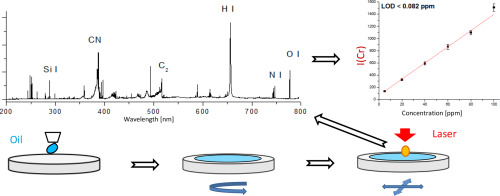当前位置:
X-MOL 学术
›
Spectrochim. Acta B. At. Spectrosc.
›
论文详情
Our official English website, www.x-mol.net, welcomes your
feedback! (Note: you will need to create a separate account there.)
Quantification of heavy metals in oils with ΜL volume by laser induced breakdown spectroscopy (libs) and minimazing of the matrix effect
Spectrochimica Acta Part B: Atomic Spectroscopy ( IF 3.2 ) Pub Date : 2020-02-01 , DOI: 10.1016/j.sab.2020.105765 M. Vinić , E. Aruffo , F. Andreoli , M. Ivković , V. Lazic
Spectrochimica Acta Part B: Atomic Spectroscopy ( IF 3.2 ) Pub Date : 2020-02-01 , DOI: 10.1016/j.sab.2020.105765 M. Vinić , E. Aruffo , F. Andreoli , M. Ivković , V. Lazic

|
Abstract In this work we describe a method for preparation and analysis of oils by Laser Induced Breakdown Spectroscopy (LIBS), aimed to minimize the necessary sample volume and the matrix effect while maximizing the detection sensitivity and measurement's repeatability. The preparation procedure consists in stabilizing the oil sample and silica wafer substrate at a fixed temperature, here of 40 °C, and in delivering an oil droplet on the wafer rotated by a spin coater. In this way, a uniform oil film is obtained, which thickness is controlled through the rotation speed. So prepared target is then scanned by using the LIBS instrument. From comparative measurements on the pure oil and oil containing 2100 ppm of various elements, we studied different potentials sources of the matrix effect. During the sample preparation, above a certain rotation speed the thickness of the liquid film is the same for the two oils although their kinematic viscosities are very different, meaning that the volume sampled by LIBS is the same. The measured oil transmissivity at the laser wavelength of 1064 nm significantly decreases with concentration of impurities, but this effect could be neglected when dealing with very thin films. The plasma formation threshold measured on the bulk oil samples decreases with the impurity content. In case of pure oil, also for the maximum laser energy here used (165 mJ), the plasma is mainly initiated on the wafer while the presence of impurities increases screening of the substrate by the plasma formed directly on the oil. The matrix effect disappears on a very thin film, here of 0.74 μm, where the C I line intensity in plasma does not vary with the total concentration of impurities between zero and 2100 ppm; simultaneously, the plasma emission becomes stable from one laser pulse to another, contrary to the case of a thick liquid layer. At 0.5 μs from the laser pulse the plasma electron density is much higher in presence of oil than on the bare substrate because of the initial plume confinement. In the optimized experimental conditions the plasma emission from oil was very intense although the sample volume probed by each laser pulse was of 0.3 nL only. By choosing properly the signal acquisition delay and the calibration procedure, the latter is dependent on the excitation energy of the analytical lines, we obtained the detection limits of 3.9 ppm, 0.49 ppm, 0.16 ppm and 0.082 ppm for Zn, Cd, Cu and Cr in oil, respectively.
中文翻译:

通过激光诱导击穿光谱 (libs) 和最小化基质效应对 ML 体积的油中重金属进行定量
摘要 在这项工作中,我们描述了一种通过激光诱导击穿光谱 (LIBS) 制备和分析油类的方法,旨在最大限度地减少必要的样品体积和基质效应,同时最大限度地提高检测灵敏度和测量的可重复性。制备过程包括在固定温度下稳定油样和二氧化硅晶片基底,此处为 40 °C,并在由旋涂机旋转的晶片上输送油滴。这样就得到了均匀的油膜,其厚度是通过转速来控制的。然后使用 LIBS 仪器扫描准备好的目标。通过对纯油和含有 2100 ppm 各种元素的油的比较测量,我们研究了基质效应的不同潜在来源。在样品制备过程中,超过一定转速时,两种油的液膜厚度相同,尽管它们的运动粘度非常不同,这意味着 LIBS 采样的体积是相同的。在 1064 nm 激光波长下测得的油透射率随着杂质浓度的增加而显着降低,但在处理非常薄的薄膜时这种影响可以忽略不计。在散装油样品上测得的等离子体形成阈值随着杂质含量的增加而降低。在纯油的情况下,同样对于此处使用的最大激光能量 (165 mJ),等离子体主要在晶片上引发,而杂质的存在增加了直接在油上形成的等离子体对基板的筛选。基质效应在非常薄的薄膜上消失,这里为 0.74 μm,其中等离子体中的 CI 谱线强度不随 0 到 2100 ppm 之间的杂质总浓度而变化;同时,等离子体发射从一个激光脉冲到另一个激光脉冲变得稳定,这与厚液体层的情况相反。在距离激光脉冲 0.5 μs 处,由于初始羽流限制,油存在下的等离子体电子密度比裸基板上的高得多。在优化的实验条件下,尽管每个激光脉冲探测的样品体积仅为 0.3 nL,但油中的等离子体发射非常强烈。通过正确选择信号采集延迟和校准程序,后者取决于分析线的激励能,我们获得了3.9ppm,0.49ppm,0.16ppm和0.082ppm的检测限,对于Zn,Cd,Cu和Cr为0.082ppm分别在石油中。
更新日期:2020-02-01
中文翻译:

通过激光诱导击穿光谱 (libs) 和最小化基质效应对 ML 体积的油中重金属进行定量
摘要 在这项工作中,我们描述了一种通过激光诱导击穿光谱 (LIBS) 制备和分析油类的方法,旨在最大限度地减少必要的样品体积和基质效应,同时最大限度地提高检测灵敏度和测量的可重复性。制备过程包括在固定温度下稳定油样和二氧化硅晶片基底,此处为 40 °C,并在由旋涂机旋转的晶片上输送油滴。这样就得到了均匀的油膜,其厚度是通过转速来控制的。然后使用 LIBS 仪器扫描准备好的目标。通过对纯油和含有 2100 ppm 各种元素的油的比较测量,我们研究了基质效应的不同潜在来源。在样品制备过程中,超过一定转速时,两种油的液膜厚度相同,尽管它们的运动粘度非常不同,这意味着 LIBS 采样的体积是相同的。在 1064 nm 激光波长下测得的油透射率随着杂质浓度的增加而显着降低,但在处理非常薄的薄膜时这种影响可以忽略不计。在散装油样品上测得的等离子体形成阈值随着杂质含量的增加而降低。在纯油的情况下,同样对于此处使用的最大激光能量 (165 mJ),等离子体主要在晶片上引发,而杂质的存在增加了直接在油上形成的等离子体对基板的筛选。基质效应在非常薄的薄膜上消失,这里为 0.74 μm,其中等离子体中的 CI 谱线强度不随 0 到 2100 ppm 之间的杂质总浓度而变化;同时,等离子体发射从一个激光脉冲到另一个激光脉冲变得稳定,这与厚液体层的情况相反。在距离激光脉冲 0.5 μs 处,由于初始羽流限制,油存在下的等离子体电子密度比裸基板上的高得多。在优化的实验条件下,尽管每个激光脉冲探测的样品体积仅为 0.3 nL,但油中的等离子体发射非常强烈。通过正确选择信号采集延迟和校准程序,后者取决于分析线的激励能,我们获得了3.9ppm,0.49ppm,0.16ppm和0.082ppm的检测限,对于Zn,Cd,Cu和Cr为0.082ppm分别在石油中。









































 京公网安备 11010802027423号
京公网安备 11010802027423号